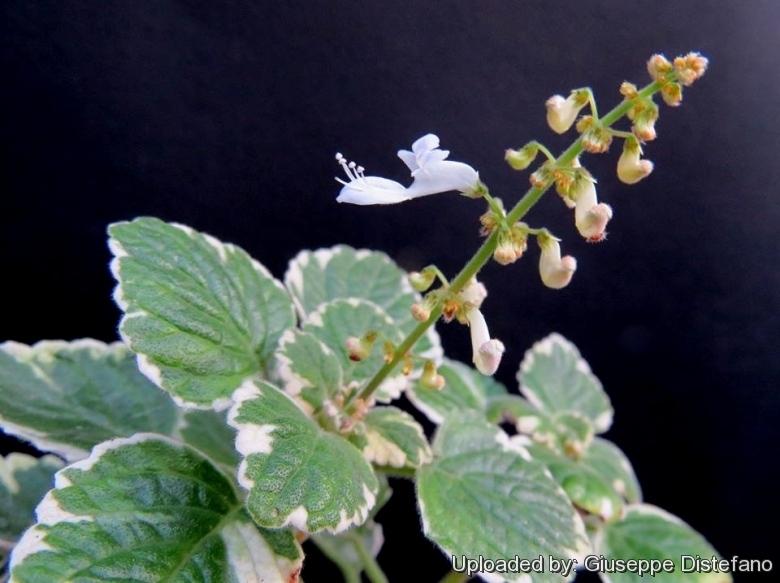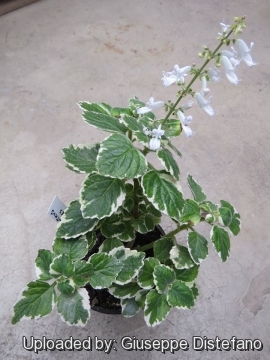= Plectranthus forsteri cv. Marginatus
Accepted Scientific Name: Plectranthus forsteri
Labiat. Gen. Spec. 38 1832

Plectranthus forsteri cv. Variegatus (Plectranthus forsteri cv. Marginatus) Photo by: Giuseppe Distefano
Origin and Habitat: Garden origin. The natural species comes from New Caledonia, Fiji and Loyalty Islands.
Synonyms:
See all synonyms of Plectranthus forsteri
back
Accepted name in llifle Database:Plectranthus forsteri Benth.Labiat. Gen. Spec. 38 1832
Cultivars
(1):
back
Common Names include:
ENGLISH: Variegated plectranthus
Description: Plectranthus forsteriSN|29700]]SN|29700]] (also sold as P. coleoides or without any indication of species) is a bushy small shrub to 25-30 cm tall and 60 or ore cm wide with green, scalloped leaves about 5 cm long.
Variegated form: The variegated form of Plectranthus forsteriSN|29692]]SN|29700]], which has the cultivar name of 'Marginatus' ('Variegatus') is a bushy variant with leaves nicely margined with cream. this variegated variety is the one normally grown. It has spires of pale mauve or white flowers in autumn.
Remarks: This plant should not be confused with genuine Plectranthus coleoidesSN|29700]]SN|29692]] Bentham, a different specie native to India that is not generally cultivated. The erroneous use of the name “coleoides” has caused much confusion among plant fanciers and growers about this species than about any other Plectranthus species.
Habit: Plectranthus forsteriSN|29700]]SN|29700]] is a spreading or trailing perennial sub-shrub over a metre wide. lant actually grows taller than 30 cm but branches droop due to weight of leaves.
Stems: Sparsely downy with both long and short hairs. Branches up to 60 cm long.
Leaves: (1.5-)3.5-5(-6) x (1-)2-3(-4) cm, ovate to broadly ovate, hairless or hairy, lower surface glandular, green with irregular creamy white crenately-toothed margins. Margin with 3-6 pairs of scallops; base almost cordate to wedge-shaped; apex obtuse. Petiole to 3.5 cm.
Inflorescence: Racemose, 7-25 cm long whorls 6-10-flowered.
Flowers: Small white or pale mauve with purple markings blooming intermittently throughout the year once established. Calyx 1.3-2.5mm enlarging in fruit to 3.5-4.5 mm. Corolla 3-8 mm, tube curved downwards, upper side almost straight, white to mauve.
Fruits (nutlets): 0.7-1 mm, dark brown, shiny, almost spherical.
Subspecies, varieties, forms and cultivars of plants belonging to the Plectranthus forsteri group
- Plectranthus forsteri Benth.: is a bushy small shrub to 40-60 cm tall and 120 cm wide with green, scalloped leaves about 5 cm long. Distribution: New Caledonia, Fiji, Loyalty Islands.
 Plectranthus forsteri cv. Marginatus: has leaves margined with cream and small white flowers; this variegated variety is the one normally grown.
Plectranthus forsteri cv. Marginatus: has leaves margined with cream and small white flowers; this variegated variety is the one normally grown.
Bibliography: Major references and further lectures
1) Christopher Brickell “RHS Encyclopedia of Plants and Flowers” Dorling Kindersley Ltd, 01/Sep/2010
2) James Cullen, Sabina G. Knees, H. Suzanne Cubey “The European Garden Flora Flowering Plants: A Manual for the Identification of Plants Cultivated in Europe, Both Out-of-Doors and Under Glass” Cambridge University Press, 11/Aug/2011
3) Graf, Alfred Byrd. “Tropica : color cyclopedia of exotic plants and trees for warm-region horticulture in cool climate the summer garden or sheltered indoors” East Rutherford, N.J. : Roehrs Co., 1981
4) Contributions to the Queensland herbarium 20: f. 2Q. 4C. 17D. 22, 31 (1971)
 Plectranthus forsteri cv. Variegatus (Plectranthus forsteri cv. Marginatus) Photo by: Giuseppe Distefano
Plectranthus forsteri cv. Variegatus (Plectranthus forsteri cv. Marginatus) Photo by: Giuseppe DistefanoSend a photo of this plant.The gallery now contains thousands of pictures, however it is possible to do even more. We are, of course, seeking photos of species not yet shown in the gallery but not only that, we are also looking for better pictures than those already present.
Read More... Cultivation and Propagation: Plectranthtis forsteri cv. Marginatus is a lovely semi-trailing tender perennial plant, for the urban garden in warmer zones or warm-weather annual. It grows quickly in a well-drained, semi-shaded position and tolerates drought and root-competition. It grow may grow in shadier parts of the garden under trees in very ordinary soil where many plants do not thrive and can be divided into clumps if it spreads too far. No pest problems so far. It is frost tender and grows well in sub-tropical and tropical locations, but will do well in cooler climates if grown in a pot and brought indoors, or moved to a warm sheltered position in winter. It needs little attention - and is quite hardy in a cool, well-lit conservatory or glasshouse, but grow well in a bright spot in the house too, need full sun to partial shade or high interior lighting with a well-drained soil mix.
Exposure: Dappled shade to half sun; this species thrives in dry, luminous locations. If it is getting too much sun, the leaves turn yellow, start curling and look unsightly. When grown under shady or partly shady conditions, it becomes scraggly and unattractive. It ideally should be grown in a semi-shaded as the leaves will remain a beautiful jade-green colour. It will also grow in the most uncongenial shady places and can form a dense carpet under trees or shrubs, and brings light into gloomy areas.
Waterings: The plants are regularly watered and allowed to dry before watering again, pay attention don't overwater as stems may rot at the soil line. Some suggest to water just enough to keep the leaves from shrivelling this keep the plants more compact and enhances the leaves scent. If too much water is used, the leaves will turn yellow and get mushy. During the winter months, keep them quite dry or only water enough to keep the leaves from shrivelling.
Fertilization: Fertilizer is usually applied only once during the growing season and it is diluted to half strength. It enjoys being mulched and fed occasionally but is really a plant that will grow despite being neglected.
Hardiness: The plant dislikes hard frosts (USDA hardiness zones 10-11), but if grown under a canopy of trees, will usually be well protected from lighter frosts.
Maintenance: The plants will vine but can be pinched to keep compact. They are all very brittle and break easily. Don't put them where people will knock against them or high wind areas, for they will lose branches and look lopsided. The stems should be cut back fairly hard after flowering (or in early spring in cooler areas if there is the risk of frosts). It is very easily propagated from cuttings in spring and autumn. All Plectranthus need to be replaced by new cuttings every so often as they get a bit straggly after a few years.
Use:
Propagation. From soft-wood cuttings at any time during the growing season, cutting will grow within days. Rarely grown from seed because the plants seldom flower and set seed.











